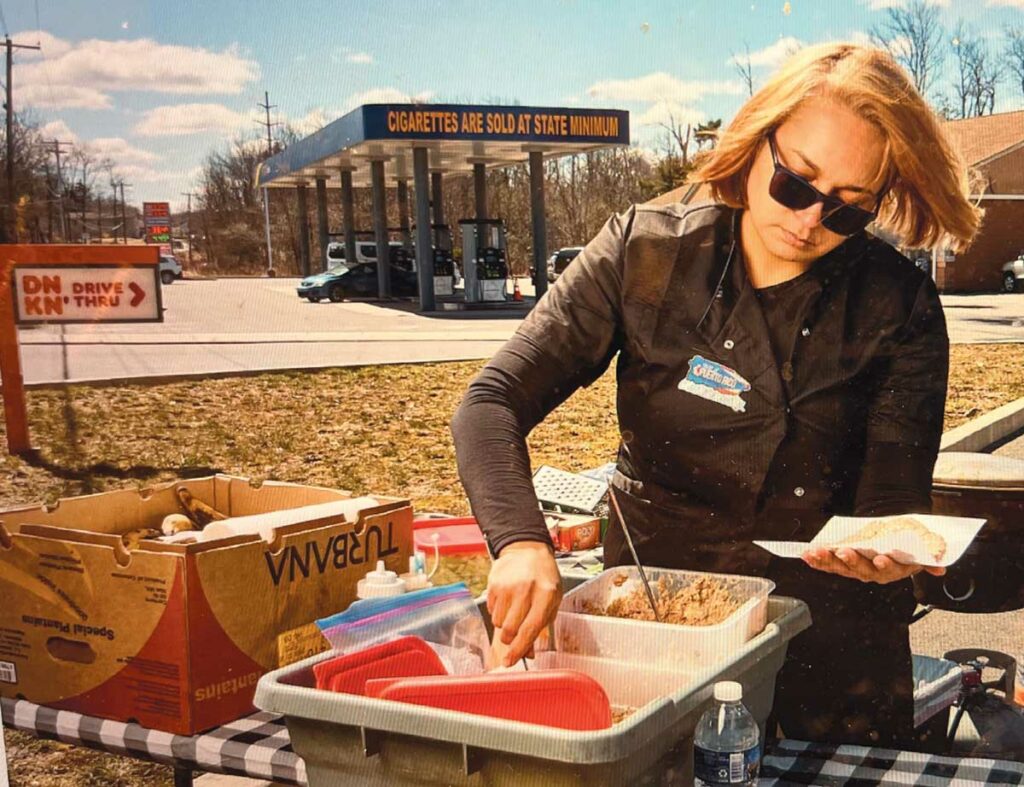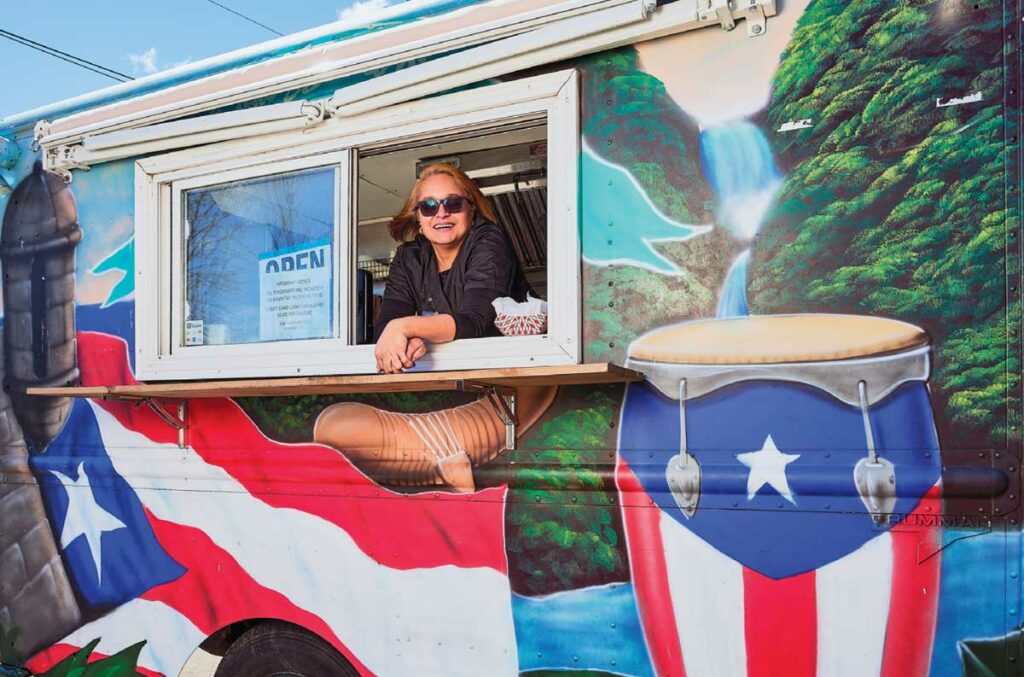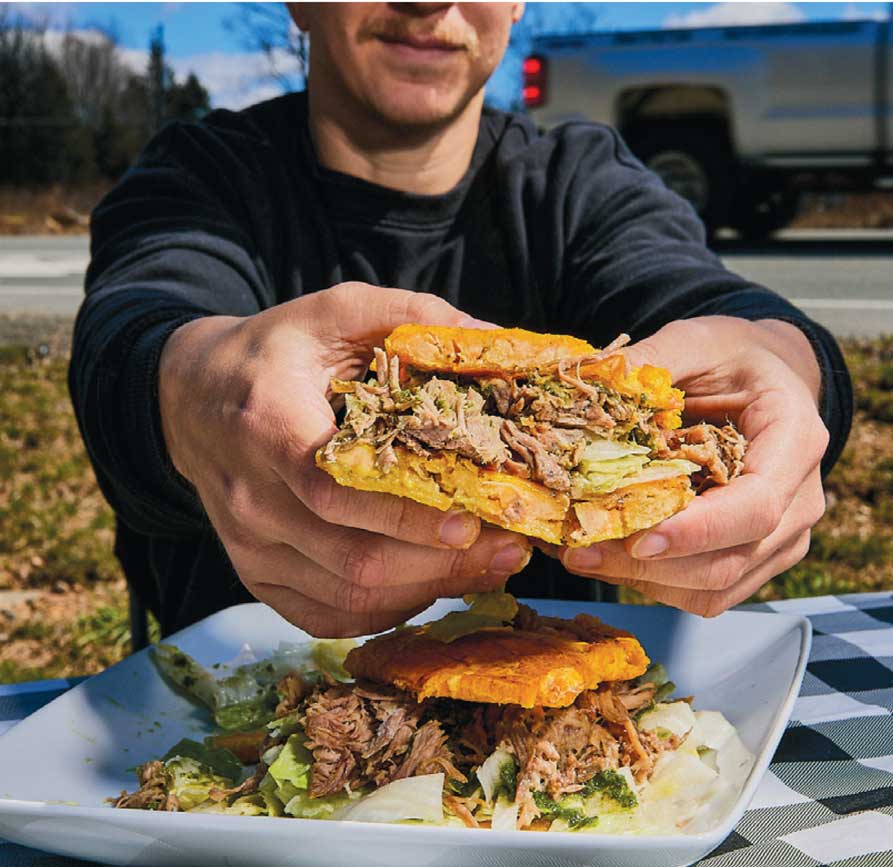BY TIM VETTER | PHOTOS BY HELEN HO

IT’S THE MASSIVE FLAG PAINTED ON THE SIDE OF THE FOOD TRUCK, with its five stripes and one white star, that first draws customers to Taste of Puerto Rico. Locals, road trippers, and weekenders, many of whom recognize this as the flag of their homeland, pull their cars to a halt when they recognize its design. Parked in empty lots, gas stations, and truck stops—places known more for their convenience than for incredible taste—the Taste of Puerto Rico food truck has been feeding those wise or curious enough to stop, all thanks to its proprietor, Lucy Sotolongo.
Like many people, Sotolongo was hit hard by the Covid pandemic. After a job loss, her family needed a new source of income. She had already become the go-to cook whenever members of her social circle were hosting an event or celebration; friends and family had grown to love the Puerto Rican dishes she made. And while other Caribbean food cultures are represented in the Poconos, Puerto Rican options were not. She seized the opportunity and decided a food truck made the most sense. Her success has been a pleasant surprise. “I never knew how many Puerto Ricans were on the mountain until I started the business,” she says.
Sotolongo was born in Rio Piedras, a district of San Juan, the capital city that lies on the northern coast of Puerto Rico. As a child she was exposed to her island’s beloved dishes, whose influences are drawn from three sources: the indigenous Taino culture, the Spanish colonizers (and their infatuation with pork), and the West African slaves who were brought there when the Spanish decimated the indigenous population. Puerto Rico became an unincorporated United States territory in 1917, which launched the first wave of immigration stateside.

As a preteen, Sotolongo moved with her father to Philadelphia, home to a large community of Puerto Rican migrants who refer to themselves as Boricuas, derived from the island’s indigenous name Borinquen. Sotolongo was fully emancipated by the time she turned 16 years old, and she moved throughout the Northeast during her formative late-teen years. She relied on her social network to obtain various jobs. Whenever she could, she returned to Puerto Rico to visit her grandmother and always frequented the food stalls she loved the most.
After living in New York, she settled in the Poconos, which didn’t offer Puerto Rican dining options. But more pressingly, Sotolongo also has a rare allergy to iodine, which has been added to commercial salt since the 1920s to counter an iodine deficiency in the American diet. This allergy limits her options when she wants to dine out, so learning how to cook—and to cook the food she loved and that was a strong part of her culture—was her only option. Sotolongo launched Taste of Puerto Rico food truck on July 4, 2021, with no formal culinary training, fueled by necessity and nostalgia. Initially, she rented a space on a private lot on Route 196, but she’s changed locations several times, including a stint in summer 2023 at Tobyhanna State Park—a popular summertime destination for swimming, fishing, and kayaking.
The Journey to Food Truck Ownership
There are definitely limitations to food trucks, however. Chefs don’t have the luxury of a full-sized kitchen for prep, or a walk-in refrigerator. Often, food is cooked or prepared offsite and then reheated to serve. In fact, Sotolongo does the majority of her cooking under tent cover, adjacent to the truck. The unique idea comes from near the beach in Piñones, just a few minutes from San Juan, where hungry patrons can sample from many food huts. The scene often becomes a full-day social affair.
“I wanted that vibe, to bring a bit of Puerto Rico to the mountain, so it just makes sense to cook under tent cover,” she explains. (She even has aspirations to incorporate the El Fogone style of cooking, where meals are cooked over a wood fire.)
Cooking mostly adjacent to the truck affords Lucy the ability to prepare everything fresh daily. Furthermore, cuchifritos, the term often used to describe most Puerto Rican street food and more specifically, fried pork bits, is deep fried and best served to order. Many food trucks cook their food ahead of time, given the logistical constraints, but Sotolongo knew reheating wouldn’t be an option, as fried foods become soggy the longer they sit. Other items, like pernil, the tender, succulent, slow-cooked pork dish, don’t stay juicy upon reheating. So, Sotolongo opted for a Type 3 Food License, which doesn’t allow for reheating food.
Sotolongo dances around the outdoor kitchen while she cooks, as if she choreographs her movements. In a single sequence, Sotolongo drops plantains into a bubbling pot, checks the temperature of the cooking oil, calls to her assistant for more pernil from the truck, stacks a mofongo burrito with all of the fixings, and hands a business card to an interested driver who pulls up alongside the kitchen. All the while her feet move to the rhythm of the salsa booming from a portable speaker on her prep table.
“I’m a Jackie of all trades,” she says. “I’m the executive chef, the owner, the waitress, the deejay, the prep cook—all of it.”
A Look at the Taste of Puerto Rico Food Truck Menu
Sotolongo’s dishes provide diners with a cross-section of Puerto Rican cuisine. Some menu items arer commonly eaten on the street or at home such as mofongo, a dish of fried green plantains that are mashed with garlic, salt, and chicken broth. It’s a dense, chewy comfort meal. Her pernil, the melt-in-your-mouth slow-cooked pork dish, is served alongside rice, as part of a jibarito sandwich with fried plantains in place of a bun—or in her mofongo burrito.
For the burrito, plantains are fried whole, then chopped, mashed by hand, and pressed until they become pliable like a wrap. She dresses a heaping pile of tender pernil with chimichurri, MayoKetchup (similar to Thousand Island dressing), and a mojito sauce. The burrito is finished with shredded lettuce before it is rolled into a football-sized meal. It’s Lucy’s way of playfully transforming classic Puerto Rican items.
On occasion, Sotolongo also serves items she considers more luxurious, like ensalada de camarones. This vibrant salad of shrimp, eggs, tomatoes, and avocados has a salty, citrus flavor. Specialty items are also available, such as pasteles, Puerto Rico’s version of a tamale, with a tender, boiled masa casing and a savory chicken filling. The dish has its roots in the indigenous Taino culture. Though they are traditionally eaten around Christmas because it’s a labor-intensive special dish, customers can call ahead to order pasteles throughout the year.
The most popular item at Taste of Puerto Rico is the alcapurrias. These are deep-fried fritters made from a mash of shredded green banana and taro root that are stuffed with ground beef and oregano. This crunchy, savory treat can be eaten at any time of day. “Whenever you get off the plane in Puerto Rico, the first thing you look for is an alcapurria stand,” Sotolongo says. Her customers nodded in agreement while watching Sotolongo fry more of these addicting snacks. Other popular items include empanadas, tostones (deep-fried slices of salted, crunchy plantains), and rellenos de papa (crispy fried potato balls stuffed with ground beef).
Homemade chimichurri, best known as an Argentinian condiment, serves as a dipping sauce for the alcapurrias. It’s also used as a dressing on many items, but Sotolongo tweaks it. “You know we have to make everything our own. The Puerto Rican version has more cilantro and oregano than they use in Argentina,” she says. The result adds a fragrant, floral pop to her dishes.
When Taste of Puerto Rico first opened for business, Sotolongo served 30–50 pounds of food each day. Currently, she serves around 600 pounds. She often hand-peels 50–100 pounds of plantains in a single afternoon. On her busiest days, it is common for patrons to wait in line for upwards of half an hour. But they don’t seem to mind. Many chat with Sotolongo about life back in Puerto Rico, lovingly referencing the food of their people. Some customers go on to work as Lucy’s assistant for the day, rotating with a group of family and friends who often help out. It adds to the growing legend of the woman who has become known as “The Food Truck Lady.” (This sense of community extends beyond the Poconos. Some customers passing through from places as distant as Maryland and Virginia have become loyal fans.)
You can find Sotolongo stationed outside of the Sunoco and Food Express on busy Route 196. She booked select summer dates at two private communities at Timothy Lake and Arrowhead Lake. In addition to the truck, she caters events and works as a private chef. Sotolongo doesn’t rule out a potential brick-and-mortar eatery in the future.
She welcomes the growth of the Taste of Puerto Rico community. “It’s the connection and community that means the most to me,” Sotolongo says. From the happy smiles and busy chatter of conversation from her line of customers, it is clear they appreciate her, too.
 Where to Find Taste of Puerto Rico
Where to Find Taste of Puerto Rico
Find the truck parked at 515 Sterling Road (off Route 196 near the Sunoco station) Thursday through Monday, noon to 6pm or until food runs out. (It will!)
Find at the Timothy Lake Campgrounds: June 15, 16, 22, 23, 30, July 4, 7, 13, 14, 20, 27, Aug. 4, 31, Sept. 22, 28, 29, Oct. 5
Find at Arrowhead Lake Community: June 8, 9, July 5, 6, Aug. 10, 11, Oct. 12
Find Online:
Website at puertoricointhepoconos.com
Instagram @poconos_tasteopr
Facebook at PoconosTasteofPuertoRico
Author Tim Vetter offers a bite of his mofongo.




